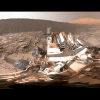Nasa spacecraft lands on Mars

Cheers and applause erupted at Nasa's Jet Propulsion Laboratory on Monday as a waist-high unmanned lander, called InSight, touched down on Mars, capping a nearly seven-year journey from design to launch to landing.
The dramatic arrival of the $993 million spacecraft -- designed to listen for quakes and tremors as a way to unveil the Red Planet's inner mysteries, how it formed billions of years ago and, by extension, how other rocky planets like Earth took shape -- marked the eighth successful landing on Mars in Nasa's history.
"Touchdown confirmed," a mission control operator at Nasa said, as pent-up anxiety and excitement surged through the room, and dozens of scientists leapt from their seats to embrace each other.
"It was intense and you could feel the emotion," said Nasa administrator Jim Bridenstine, in an interview on Nasa television afterward.
Bridenstine also said President Donald Trump and Vice President Mike Pence had watched on television and called to congratulate the US space agency for its hard work.

"Ultimately, the day is coming when we land humans on Mars," Bridenstine said, adding that the goal is to do so by the mid 2030s.
The vehicle appeared to be in good shape, according to the first communications received from the Martian surface.
But as expected, the dust kicked up during the landing obscured the first picture InSight sent back, which was heavily flecked.
France's Centre National d'Etudes Spatiales (CNES) made the Seismic Experiment for Interior Structure (SEIS) instrument, the key element for sensing quakes.
The principal investigator on the French seismometer, Philippe Lognonne, said he was "relieved and very happy" at the outcome.
And in a final crucial phase, Nasa said InSight signalled to Earth that its solar panels -- twin solar arrays spanning seven feet (2.2 meters) in width -- had opened and were collecting sunlight on the surface of Mars.
"The InSight team can rest a little easier tonight now that we know the spacecraft solar arrays are deployed and recharging the batteries," said Tom Hoffman, InSight's project manager.
The spacecraft is Nasa's first to touch down on Earth's neighbouring planet since the Curiosity rover arrived in 2012.
More than half of 43 attempts to reach Mars with rovers, orbiters and probes by space agencies from around the world have failed.
Nasa is the only space agency to have made it, and is invested in these robotic missions as a way to prepare for the first Mars-bound human explorers in the 2030s.

 For all latest news, follow The Daily Star's Google News channel.
For all latest news, follow The Daily Star's Google News channel. 








Comments